02 Apr , 2025 By : Debdeep Gupta

The market extended its downward move for another session, with the Nifty 50 sinking 1.5 percent on April 1 amid caution ahead of tariff announcements by Donald Trump. The chart pattern suggests further weakness; however, as long as the index defends the 23,100-23,000 zone (which coincides with the 50-day EMA and the upper end of the bullish gap from March 20), consolidation may continue, with a hurdle on the higher side at 23,800. A decisive break below 23,000 or above 23,800 could determine the next direction for the index, according to experts.
Here are 15 data points we have collated to help you spot profitable trades:
1) Key Levels For The Nifty 50 (23,166)
Resistance based on pivot points: 23,453, 23,554, and 23,718
Support based on pivot points: 23,125, 23,024, and 22,860
Special Formation: The Nifty 50 dropped below the 200-day EMA, as well as the 5 and 10-day EMAs, in a single session with above-average volumes, forming a bearish candle with an upper shadow on the daily charts, which indicated pressure at higher levels. The momentum indicator RSI (Relative Strength Index at 53.03) trended downward, while the MACD (Moving Average Convergence Divergence) also tilted downward but still maintained a positive bias above the zero line.
2) Key Levels For The Bank Nifty (50,828)
Resistance based on pivot points: 51,444, 51,667, and 52,026
Support based on pivot points: 50,725, 50,502, and 50,143
Resistance based on Fibonacci retracement: 51,883, 53,020
Support based on Fibonacci retracement: 50,273, 49,283
Special Formation: The Bank Nifty fell 1.4 percent and formed a bearish candle with an upper shadow on the daily timeframe but still sustained above all key moving averages (10, 20, 50, 100, and 200-day EMAs), as well as above the bullish gap of March 24. The RSI still held around 60, though it tilted downward, and the MACD maintained a positive bias well above the zero line.
3) Nifty Call Options Data
According to the weekly options data, the maximum Call open interest was seen at the 23,500 strike (with 1.33 crore contracts). This level can act as a key resistance for the Nifty in the short term. It was followed by the 24,000 strike (1.1 crore contracts), and the 23,600 strike (1.04 crore contracts).
Maximum Call writing was observed at the 23,500 strike, which saw an addition of 90 lakh contracts, followed by the 23,400 and 23,300 strikes, which added 66.21 lakh and 65.48 lakh contracts, respectively. The maximum Call unwinding was seen at the 24,250 strike, which shed 2.27 lakh contracts, followed by the 22,500 and 22,600 strikes, which shed 1.07 lakh and 44,250 contracts, respectively.
4) Nifty Put Options Data
On the Put side, the 22,500 strike holds the maximum Put open interest (with 75.78 lakh contracts), which can act as a key support level for the Nifty. It was followed by the 23,000 strike (74.18 lakh contracts) and the 22,800 strike (66.84 lakh contracts).
The maximum Put writing was placed at the 22,800 strike, which saw an addition of 23.95 lakh contracts, followed by the 23,200 and 23,000 strikes, which added 21.5 lakh and 21.09 lakh contracts, respectively. The maximum Put unwinding was seen at the 23,400 strike, which shed 14.14 lakh contracts, followed by the 23,500 and 23,550 strikes, which shed 13.92 lakh and 11.81 lakh contracts, respectively.
5) Bank Nifty Call Options Data
According to the monthly options data, the 53,000 strike holds the maximum Call open interest, with 13.12 lakh contracts. This can act as a key resistance level for the index in the short term. It was followed by the 52,000 strike (9.58 lakh contracts) and the 51,000 strike (7.57 lakh contracts).
Maximum Call writing was visible at the 51,000 strike (with the addition of 1.37 lakh contracts), followed by the 52,500 strike (1.25 lakh contracts) and the 51,100 strike (79,950 contracts). The maximum Call unwinding was seen at the 50,000 strike, which shed 46,170 contracts, followed by the 49,500 and 52,800 strikes, which shed 20,700 and 13,500 contracts, respectively.
6) Bank Nifty Put Options Data
On the Put side, the maximum Put open interest was seen at the 53,000 strike (with 12.4 lakh contracts), which can act as a key level for the index. This was followed by the 50,000 strike (9.2 lakh contracts) and the 51,000 strike (7.82 lakh contracts).
The maximum Put writing was observed at the 50,800 strike (which added 1.04 lakh contracts), followed by the 49,500 strike (65,010 contracts) and the 50,900 strike (64,890 contracts). The maximum Put unwinding was seen at the 51,500 strike, which shed 2.41 lakh contracts, followed by the 51,000 and 51,700 strikes, which shed 1.35 lakh and 65,220 contracts, respectively.
7) Funds Flow (Rs crore)
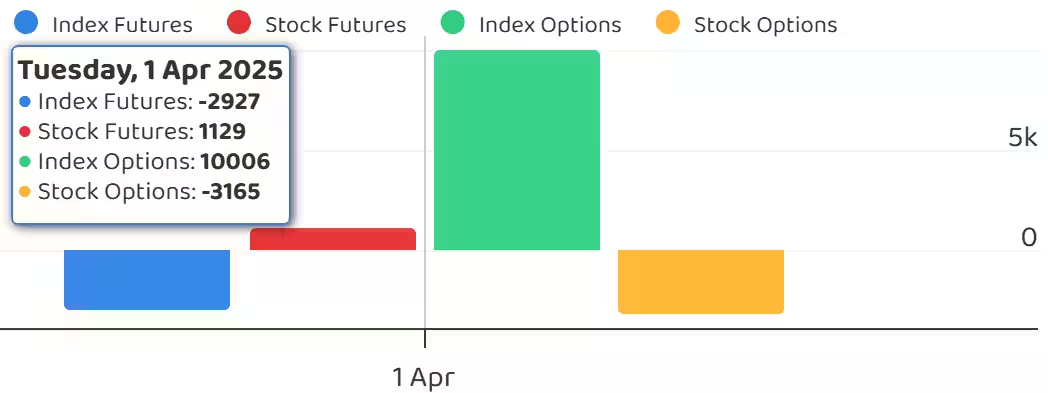
8) Put-Call Ratio
The Nifty Put-Call ratio (PCR), which indicates the mood of the market, dropped further to 0.76 on April 1, against 0.92 in the previous session.
The increasing PCR, or being higher than 0.7 or surpassing 1, means traders are selling more Put options than Call options, which generally indicates the firming up of a bullish sentiment in the market. If the ratio falls below 0.7 or moves towards 0.5, then it indicates selling in Calls is higher than selling in Puts, reflecting a bearish mood in the market.
9) India VIX
The India VIX, the fear gauge, increased sharply by 8.37 percent to the 13.78 zone and climbed above short-term moving averages (10 and 20-day EMAs), making the bulls uncomfortable.
10) Long Build-up (32 Stocks)
A long build-up was seen in 32 stocks. An increase in open interest (OI) and price indicates a build-up of long positions.
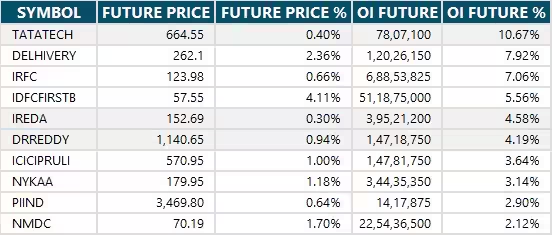
11) Long Unwinding (52 Stocks)
52 stocks saw a decline in open interest (OI) along with a fall in price, indicating long unwinding.
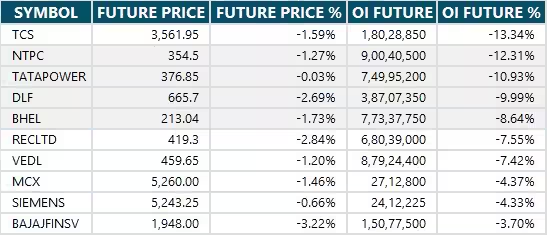
12) Short Build-up (97 Stocks)
97 stocks saw an increase in OI along with a fall in price, indicating a build-up of short positions.
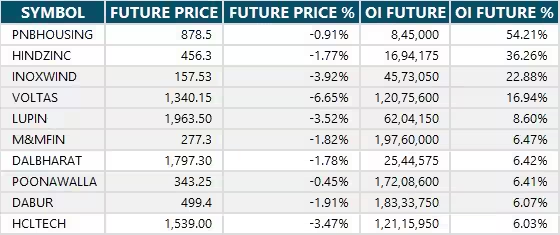
13) Short-Covering (39 Stocks)
39 stocks saw short-covering, meaning a decrease in OI, along with a price increase.
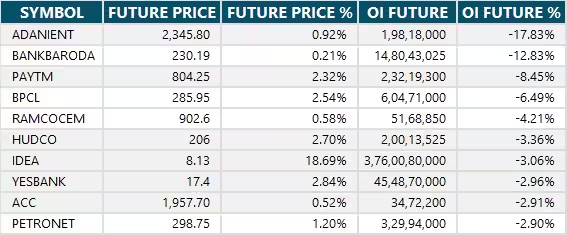
14) High Delivery Trades
Here are the stocks that saw a high share of delivery trades. A high share of delivery reflects investing (as opposed to trading) interest in a stock.

15) Stocks Under F&O Ban
Securities banned under the F&O segment include companies where derivative contracts cross 95 percent of the market-wide position limit.
Stocks added to F&O ban: Nil
Stocks retained in F&O ban: Nil
Stocks removed from F&O ban: Nil
0 Comment